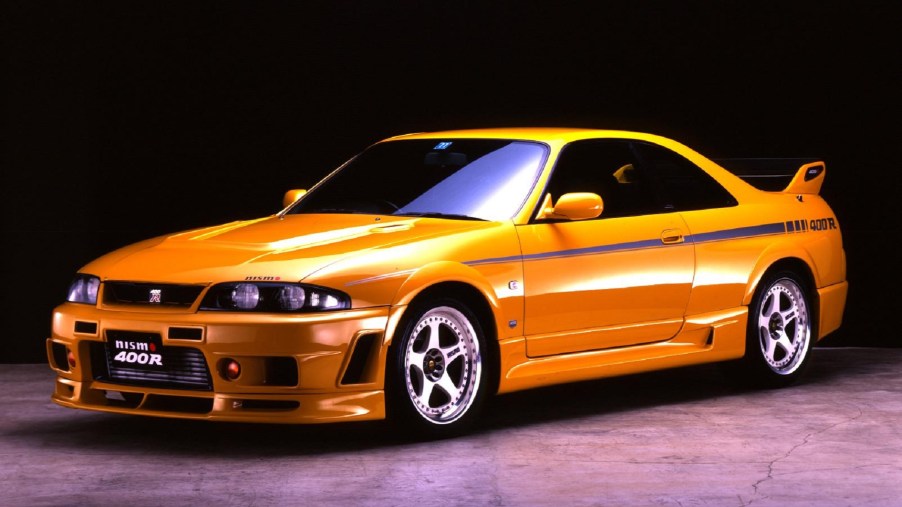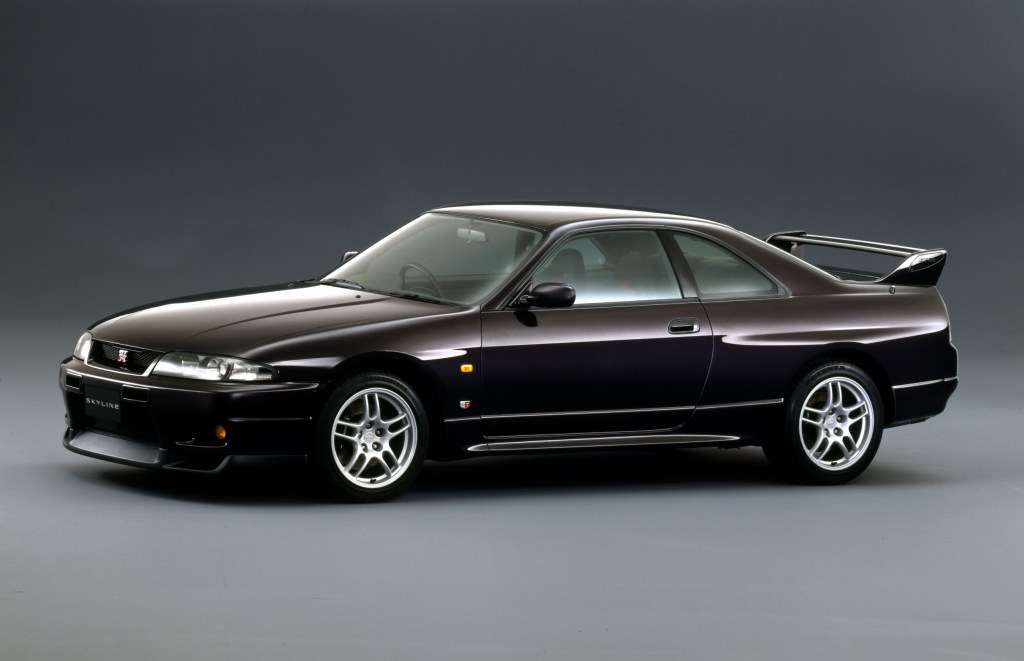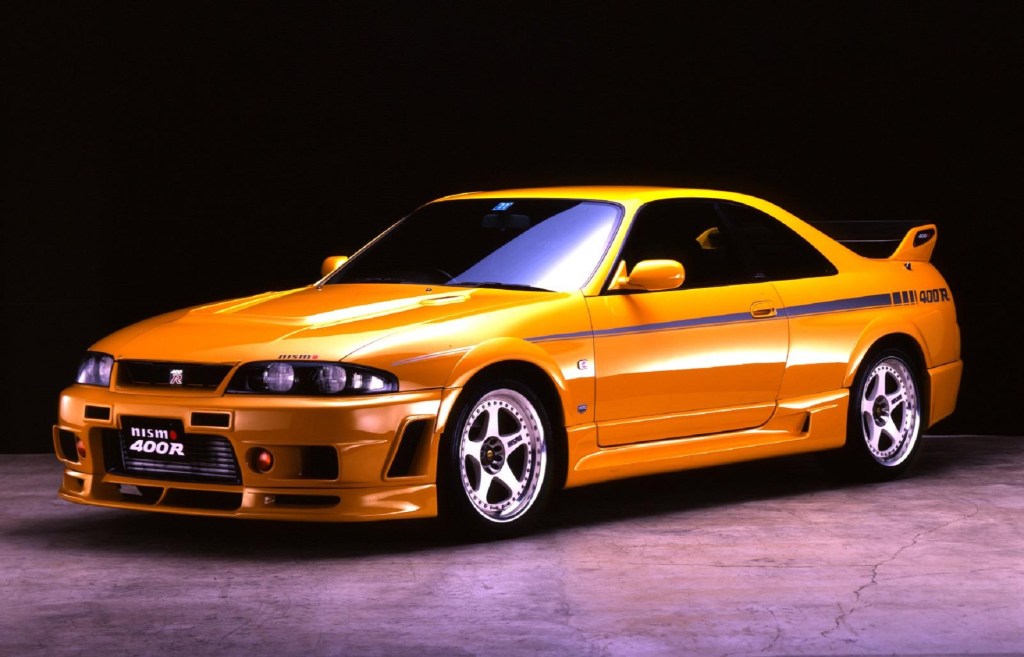
Nissan R33 Skyline GT-R Nismo 400R: From Sports to Supercar
Compared to the earlier R32, the R33 Skyline GT-R often ends up playing second fiddle. But the second-gen version of Nissan’s AWD performance icon is in many ways a better sports car than its predecessor. And while the R34 GT-R arguably has the greatest pop culture presence—not to mention market value—the R33 is right behind it. At least, one extreme and extremely rare version: the R33 Nissan Skyline GT-R Nismo 400R.
Nismo said, ‘forget the gentleman’s agreement,’ and went to work on the R33 Nissan Skyline GT-R

Nissan’s in-house tuning and racing department, Nismo, tweaks and boosts several of the brand’s current cars, including the modern GT-R. And its history of modifying Nissan Skyline GT-Rs dates to the R32’s predecessor, the 1989 R31. However, even compared to those efforts, the Nismo 400R is something special, Hagerty says. And the special-ness starts in the engine bay.
One of the Nissan Skyline GT-R’s most iconic parts is its twin-turbo 2.6-liter RB26DETT inline-six. The R32, R33, and R34 all used this famously robust engine. But the RB26 wasn’t just tough—at least in the R32 and R33, it was under-rated. That’s due to Japanese automakers’ ‘gentleman’s agreement’ whereby they officially rated their engines at no more than 276 hp. Much like motorcycle OEMs did after the Hayabusa came out, this was supposed to limit street racing and keep lawmakers from regulating sports cars to death.
It, um, didn’t really work, at least where racing was concerned. So, eventually, Nissan and Nismo decided to end the agreement and start bumping up horsepower. And the car that officially broke the truce was the 1996 R33 Skyline GT-R Nismo 400R.
The 400R is the only Nissan Skyline GT-R that doesn’t have a 2.6-liter RB26 engine. But its 2.8-liter ‘RB-X GT2’ engine is based on the RB26’s design, Hagerty explains. However, Nismo did so much more than just enlarge the R33’s engine. And the tuning division didn’t stop at the engine bay, either.
With the agreement gone, the Nismo 400R turned the R33 Nissan Skyline GT-R into a bonafide 1990s supercar

| Spec | 1996-1997 R33 Nissan Skyline GT-R Nismo 400R | 1995-1998 R33 Nissan Skyline GT-R |
| Engine | 2.8-liter twin-turbocharged ‘RB-X GT2’ inline-six | 2.6-liter twin-turbocharged ‘RB26’ inline-six |
| Power | 395 hp | 276 hp |
| Torque | 346 lb-ft | 271 lb-ft |
| Transmission | Five-speed manual | Five-speed manual |
| Curb weight | 3417 lbs | 3395 lbs |
| 0-62 mph time | 4.0 seconds (Evo) | 5.6 seconds (Evo) |
The R33 Nissan Skyline GT-R Nismo 400R doesn’t just have a bigger engine than the standard car. That RB-X has a reinforced block, stronger crankshaft and connecting, as well as new cylinder heads and ECU. It also has a full titanium exhaust—exhaust manifolds included—upgraded turbos and a dedicated oil cooler. Plus, not only did Nismo upgrade the intercooler, but it also installed a new carbon-fiber air guide.
Speaking of carbon fiber, the Nismo 400R has significantly more of it than the regular R33 Nissan Skyline GT-R. The car’s hood (with functional heat extractor), driveshaft, and new double rear wing are made from carbon fiber, too. That’s standard supercar practice today, but in the 1990s, it was extremely exotic. And there’s more titanium, too. The 400R has a titanium strut-tower brace and a titanium shift knob.
But there’s more. The R33 Nissan Skyline GT-R Nismo 400R rides 1.2” lower than the standard car on unique Bilstein dampers and Nismo springs. Nismo also installed upgraded brake pads and a new brake master cylinder for better pedal feel, Hagerty notes. Plus, the upgraded powertrain has an upgraded twin-plate clutch to match. And on top of the lower ride height and carbon-fiber wing, the 400R has functional side skirts and a redesigned front bumper with built-in brake-cooling and oil-cooler ducts. Also, because the car has wider tires and three-piece alloy wheels, it has wider fender flares.
Finally, the Nismo 400R has several interior tweaks over the R33 Skyline GT-R besides the titanium shift knob. It has Nismo bucket seats, a redesigned gauge cluster, extra gauges, and a 400R-specific steering wheel with a carbon-fiber center. Also, for better racetrack visibility, the 400R has HID headlights.
The R33 Nissan Skyline GT-R is an excellent sports car, but Hagerty says the 400R is “one of the greatest JDM performance machines of all time”
Like the modern GT-R, the R32 Skyline GT-R was a true early-1990s supercar, due in part to its technology. And while the R33 is often held in lower regard, as noted earlier, it’s better than the R32 in several ways.
Not only are its AWD and rear-wheel-steering systems more advanced, but its brakes are better, too. And it’s stiffer and more aerodynamic. Hence why, even though it’s heavier, the R33 Skyline GT-R beat the R32’s Nürburgring time and became the first production car to run it in under eight minutes.
The Nismo 400R, though, takes the R33 Nissan Skyline GT-R even further into supercar territory. Its engine is just “a living, breathing monster,” Evo says, and it responds even better than the stock RB26. The upgraded brakes are “sensational,” and the rear-wheel steering system is so anti-understeer that it’s almost spooky. And while the suspension is firm, it’s never harsh; and the upside is incredible body control. Plus, while the steering is a bit heavy at low speeds, it’s full of feedback and extremely quick.
The 400R might be 25 years old, but it handles like a much more modern car. And it still feels like a supercar.
Good luck trying to find one of these JDM supercar legends
Classic Nissan Skyline GT-Rs, especially the sportier versions like the V-Spec models, are all going up in value. And that includes the R33, which became legal to import in 2020. However, the Nismo 400R is in a league of its own, even compared to the iconic R34. And that has as much to do with its upgraded components as its rarity.
Nismo claims that it made 44 R33 Skyline GT-R 400Rs. But the official GT-R Registry only has validated records of 40 cars. Outside of one-off race cars, that makes the 400R the rarest Skyline GT-R variant. As such, it’s also the most expensive.
Because there are so few genuine 400Rs out there, it’s difficult to keep track of market trends. But according to Hagerty, even a fair-condition example typically goes for $800,000. And a pristine, low-mileage 400R? That’s $1 million easy.
So, if you still needed to be convinced that the R33 Nissan Skyline GT-R Nismo 400R is a true supercar, know that’s priced like one, too.
Follow more updates from MotorBiscuit on our Facebook page.


